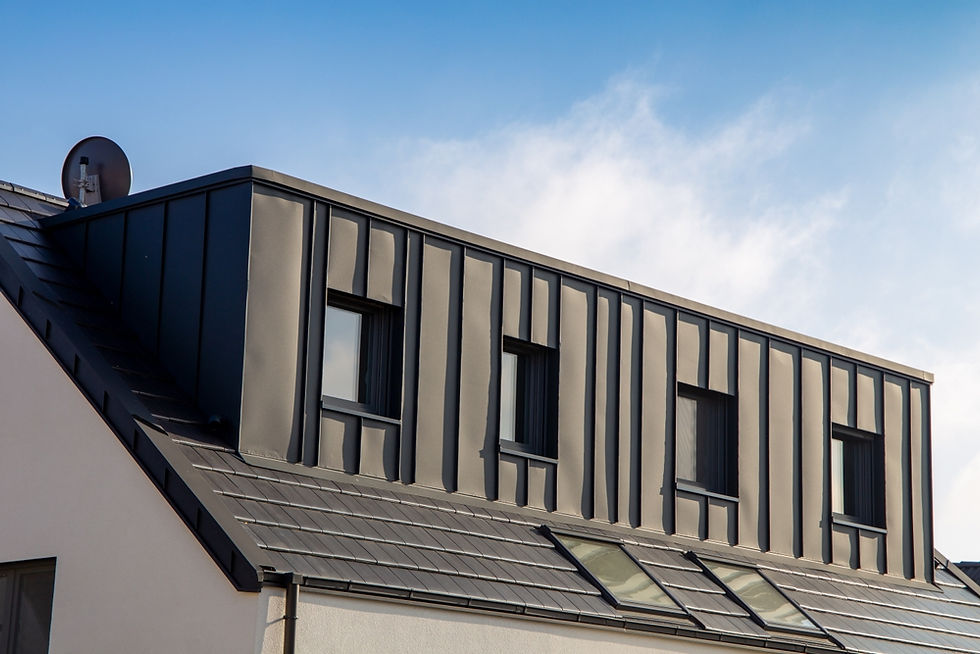Understanding the Durability and Endless Lifespan of Zinc Wall Cladding
- annawrench1315
- Oct 22, 2024
- 3 min read
Updated: Nov 6, 2025
Have you ever wondered how some building exteriors maintain their texture and shine throughout the changing seasons? Or questioned, why some construction materials seem to withstand the test of time better than others? The secret lies in the cladding. Wall cladding, to be precise, and one hero material that has emerged in the spectrum of cladding materials is zinc.
Zinc was used as a construction material in Greece over 2,500 years ago, and buildings with this material still standing strong are a testament to its endurance. It is no wonder why architects and designers adore zinc for its durability, versatility, and sleek aesthetic appeal. Through this post, let us delve into the world of zinc wall cladding, uncover its features and understand what contributes to its remarkable longevity.
Investing in the right wall cladding is a critical decision that carries significant implications for your building's aesthetics and structural integrity. Comprehending the benefits and potential drawbacks of zinc as a cladding material can influence your decision-making process and help you steer your architectural venture to success.

The Origin and Popularity of Zinc Wall Cladding
Zinc wall cladding has its roots steeped deep in European history, where it debuted as a roofing material. The durability, aesthetic appeal, and flexibility offered by zinc made it an instant hit, leading to diversified applications, including wall cladding. It also has a significant advantage that can contribute to its use in green buildings with its 100% recyclability.
What Makes Zinc Wall Cladding Remarkably Durable?
The secret of zinc wall cladding’s exceptional endurance lies in the protective patina that forms on its surface. zinc naturally forms a protective patina when exposed to the elements. This patina not only enhances its appearance but also acts as a self-healing layer, effectively sealing small scratches and preventing corrosion. This patina acts as a barrier against corrosion, thus enhancing zinc's lifespan.
The Aesthetic Versatility of Zinc Wall Cladding
Zinc as a cladding material is a winning choice for its pleasing aesthetic versatility. Available in various finishes and colors, it bends willingly to the creative whims of architects.

The Pros and Cons of Zinc Wall Cladding
Like any material, zinc wall cladding has its share of pros and cons. While its durability, aesthetic versatility, and ecological friendliness are praiseworthy, its higher upfront costs may pose a hurdle for some.
Zinc Wall Cladding – A Vital Player in Sustainable Architecture
Zinc wall cladding has emerged as a particularly vital player in the pursuit of sustainable and resilient architecture, thanks to its recyclability and long lifespan.
Conclusion
When considering wall cladding options for your next architectural project, the selection of material becomes crucial. With its enduring lifespan, ability to withstand harsh weather conditions, and aesthetic versatility, zinc wall cladding proves to be a hero. Despite the initial higher cost, its incredible durability and low maintenance offer cost efficiency in the long run. Truly, the allure of zinc wall cladding is not restricted to its surface alone - it's a deep-seated testament to the wisdom of merging the old-world charm with contemporary sustainability.
Zinc is highly resistant to the elements, including extreme weather conditions and UV exposure, ensuring that it maintains its integrity for decades. Additionally, zinc is a recyclable material, further extending its lifecycle and reinforcing its reputation as an eco-friendly and low-maintenance cladding solution. This combination of resilience, minimal upkeep, and environmental benefits makes zinc wall cladding an ideal option for both residential and commercial buildings seeking a balance of functionality and style.








Comments